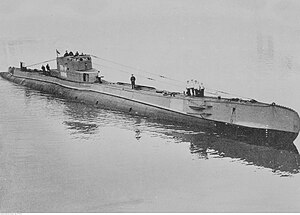ORP Orzeł (1938)

ORP Orzeł entering the Hel peninsula naval base, 1930s
|
|
| History | |
|---|---|
|
|
|
| Name: | ORP Orzeł |
| Namesake: | Eagle |
| Builder: | De Schelde, Netherlands |
| Laid down: | 14 August 1936 |
| Launched: | 15 January 1938 |
| Commissioned: | 2 February 1939 |
| Decommissioned: | 11 June 1940 |
| Fate: | missing, presumably sunk |
| General characteristics | |
| Class and type: | Orzeł-class submarine |
| Displacement: |
|
| Length: | 84.00 m (275 ft 7 in) |
| Beam: | 6.7 m (22 ft 0 in) |
| Draught: | 4.17 m (13 ft 8 in) |
| Speed: |
|
| Complement: | 60 |
| Armament: |
|
ORP Orzeł was the lead ship of her class of submarines serving in the Polish Navy during World War II. Her name means "Eagle" in Polish. The boat is best known for the Orzeł incident, her escape from internment in neutral Estonia during the early stages of the Second World War.
Orzeł was laid down 14 August 1936 at the Dutch shipyard De Schelde, as the Job No. 205; launched on 15 January 1938, and commissioned on 2 February 1939. She was a modern design (designed by the joint venture of Polish and Dutch engineers), albeit quite large for the shallow waters of the Baltic Sea.
At the beginning of the invasion of Poland Orzeł was docked in Oksywie. As per the Worek Plan, the submarine was deployed on patrol in a designated strategic zone of the Baltic Sea. The crew received specific orders to attack the pre-dreadnought Schleswig-Holstein, should it leave Danzig. With the situation rapidly deteriorating, Orzel abandoned its assigned sector on 4 September, and began to withdraw into the Baltic Sea. The submarine was attacked by the German minesweepers M3 and M4 and damaged, but evaded that evening.
Orzel's crew decided to head to Tallinn, Estonia as a result of the damage. Orzeł reached Tallinn on 14 September 1939. On 15 September the captain, Lieutenant-Commander Henryk Kłoczkowski, was forced to leave the submarine to undergo hospital treatment for an unknown illness he had been suffering from since 8 September. Under the Hague Convention of 1907, section XIII, Article 12, "belligerent ships" could enter a neutral port but were forbidden from remaining there for "more than twenty-four hours." At the insistence of Germany, the Estonian military authorities boarded the ship, interned the crew, confiscated all the navigation aids and maps, and commenced removing all her armaments. However, only fifteen of her twenty torpedoes were removed before the hoist cable parted; this was because it had been secretly sabotaged by her new commander, former chief officer, Lieutenant Jan Grudzinski.
...
Wikipedia
